Thien Mu Pagoda, the most renowned pagoda in Hue, is celebrated for its ancient architecture, sanctity, and rich mythology. As one of Hue’s preserved national treasures, this 400-year-old sanctuary is steeped in fascinating historical legends. Join Frontier Travel Vietnam to explore the remarkable features of Thien Mu Pagoda.
.png)
Thien Mu Pagoda history
Thien Mu Pagoda, also known as the Pagoda of the Celestial Lady, has a rich and storied history that dates back over four centuries. It was originally founded in 1601 by Nguyen Hoang, the governor of Thuan Hoa province, who later became the first Nguyen lord. According to legend, Nguyen Hoang chose the site for the pagoda after hearing of a prophecy that a great leader would build a pagoda at this location to bring peace and prosperity to the region.
Over the years, the pagoda has undergone several renovations and expansions. In the early 18th century, Lord Nguyen Phuc Chu had the pagoda refurbished, adding several new structures, including the iconic seven-story Phuoc Duyen Tower, which was erected in 1844 and remains a symbol of Hue.
Today, Thien Mu Pagoda remains a vital religious site and a popular tourist attraction, drawing visitors with its serene beauty, historical significance, and the tranquil setting along the banks of the Perfume River. The pagoda complex includes several important buildings, statues, and artifacts, making it a must-visit destination for those interested in Vietnamese history and culture.
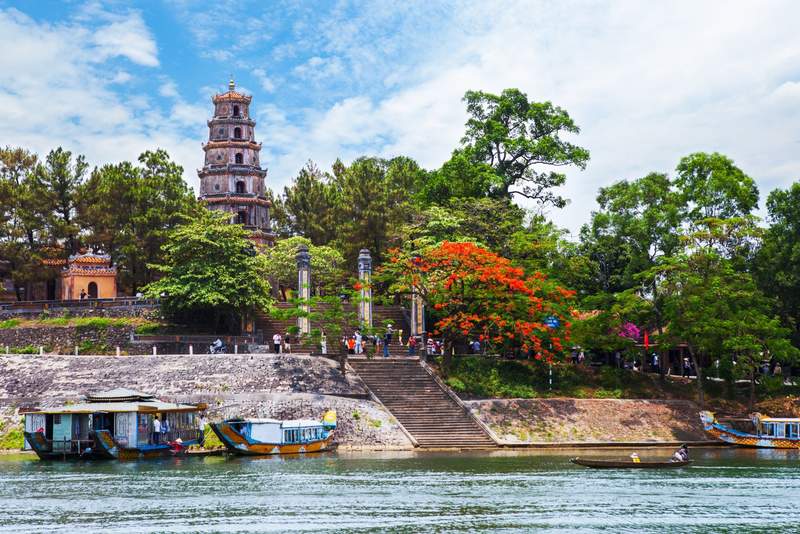
Why is the Thien Mu Pagoda important?
Thien Mu Pagoda holds immense historical significance, particularly evident during the tumultuous summer of 1963 in South Vietnam. At this time, widespread discontent among the Buddhist majority towards President Ngo Dinh Diem's discriminatory policies reached a boiling point. Diem's administration heavily favored Catholics in military roles, public service, and governmental aid distribution, exacerbating tensions.
The catalyst for mass protests occurred during Vesak, the birthday of Gautama Buddha, when nine Buddhists were tragically killed by Diem's army and police in Hue. This event sparked nationwide Buddhist demonstrations, which rapidly gained momentum. Thien Mu Pagoda emerged as a pivotal center for these protests, serving as a focal point for organizing hunger strikes, erecting barricades, and staging demonstrations against Diem's regime.
Beyond its role in political resistance, Thien Mu Pagoda stands as a testament to Vietnam's enduring cultural heritage. Its serene setting along the Perfume River and ancient architectural splendor continue to attract visitors seeking to explore its rich history and spiritual significance.
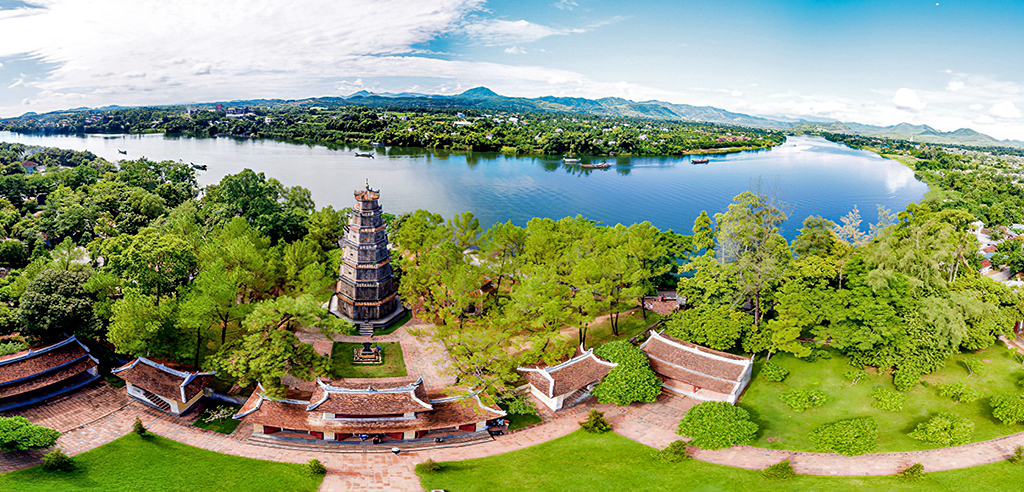
How do you get to Thien Mu Pagoda?
Thien Mu Pagoda is conveniently located approximately 5km from the center of Hue city, making it easily accessible by various means of transport:
By Motorbike
Renting a motorbike offers flexibility and independence. From the Imperial City of Hue, head south on Kim Long Street. After about 2 km, you will reach Thien Mu Pagoda. The route is straightforward and allows you to explore at your own pace.
Rental prices typically range from 100,000 to 150,000 VND per day, depending on the type of motorbike and rental duration.
By Boat
Taking a boat to Thien Mu Pagoda provides a scenic journey along the Perfume River (Huong River). You can enjoy views of lush greenery and historic sites along the riverbanks. Boats depart from various points along the river, including near the Truong Tien Bridge in central Hue.
The boat ride takes approximately 30 minutes to reach Thien Mu Pagoda. Prices vary, but expect to pay around 150,000 to 200,000 VND per person for a round trip, depending on the type of boat and negotiation skills.
By Bicycle
Cycling to Thien Mu Pagoda allows you to enjoy the city's streets and riverside scenery at a leisurely pace. Start early in the morning to avoid traffic and the heat of midday. Begin from central Hue and head south along the Perfume River. Follow the signs or use a GPS app for guidance.
Cycling typically takes about 20 to 30 minutes from central Hue to Thien Mu Pagoda, depending on your cycling speed and stops along the way. Rent bicycles from local shops or your accommodation. Prices range from 50,000 to 100,000 VND per day.
By Cyclo
Riding a cyclo (pedicab) to Thien Mu Pagoda is a relaxing way to soak in the sights and sounds of Hue. Cyclo drivers often provide commentary and point out notable landmarks along the route.
Cyclos can navigate through city streets and along the Perfume River, offering a unique perspective of Hue's scenery. Cyclo fares vary depending on the distance and negotiation skills. Expect to pay between 40,000 to 100,000 VND per trip.
By Taxi
Taxis are the most convenient option for travelers seeking direct and comfortable transportation to Thien Mu Pagoda. Choose between traditional taxis or eco-friendly options like XANH SM Taxi, which operates in Hue.
Taxi fares are metered. The cost from central Hue to Thien Mu Pagoda should be around 50,000 to 100,000 VND, depending on traffic and the taxi service chosen.
Each transportation option offers a unique way to experience Hue and reach Thien Mu Pagoda, allowing you to choose based on your preferences for convenience, adventure, or cultural immersion.
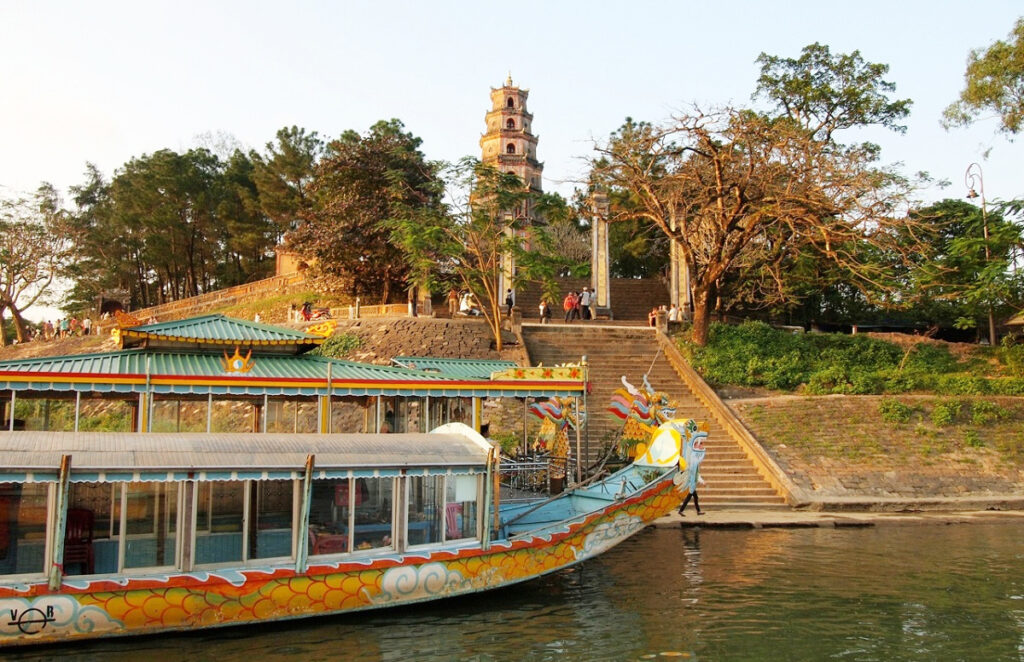
FAQ About Thien Mu Pagoda
Planning a visit to Thien Mu Pagoda? Here are some frequently asked questions to help you make the most of your trip.
Thien Mu Pagoda opening hours
Thien Mu Pagoda welcomes visitors throughout the day, providing flexibility for exploration. However, for the best experience, consider the following recommended times:
- Early Morning (6:00 am - 8:00 am): This time frame offers a serene atmosphere ideal for capturing stunning photos and enjoying the peaceful ambiance of the pagoda.
- Evening (5:00 pm - 6:00 pm): Experience the romantic sunset along the tranquil banks of the Huong River, providing a picturesque backdrop to your visit.
These times not only ensure optimal lighting conditions for photography but also allow you to appreciate the beauty and tranquility of Thien Mu Pagoda amidst its historical and cultural surroundings.
Thien Mu Pagoda entrance fee
Thien Mu Pagoda is open to the public free of charge. There is no entrance fee, allowing visitors to explore this historical and cultural landmark without any cost. Enjoy your visit to this serene and spiritually significant site at your leisure.
Thien Mu Pagoda dress code
As Thien Mu Pagoda in Hue is a spiritual tourist destination, please follow these guidelines during your visit:
- Wear discreet and polite clothing. Avoid clothes that are too short or revealing. Remove your hat when entering prayer areas.
- Bring an umbrella and water, especially in summer, as the large pagoda complex requires time and energy to explore.
- Maintain a respectful demeanor by not talking loudly, playing, or using profanity.
Explore the Timeless Architecture of Thien Mu Pagoda
Thien Mu Pagoda boasts a variety of architectural marvels that reflect its historical and cultural significance. Each structure within the complex offers a glimpse into the rich heritage and spiritual essence of this revered site. Here's a look at some of the key features:
Dai Hung Palace

Situated in the main hall of Thien Mu Pagoda, Dai Hung Palace is dedicated to Maitreya Buddha, symbolizing carefree joy. The statue of Maitreya Buddha, with his gentle appearance, large ears, and big belly, represents immense kindness and generosity, uplifting everyone around. The palace is constructed entirely of solid cement, with sides painted to resemble wood, creating a warm and welcoming atmosphere.
Tam Quan Gate
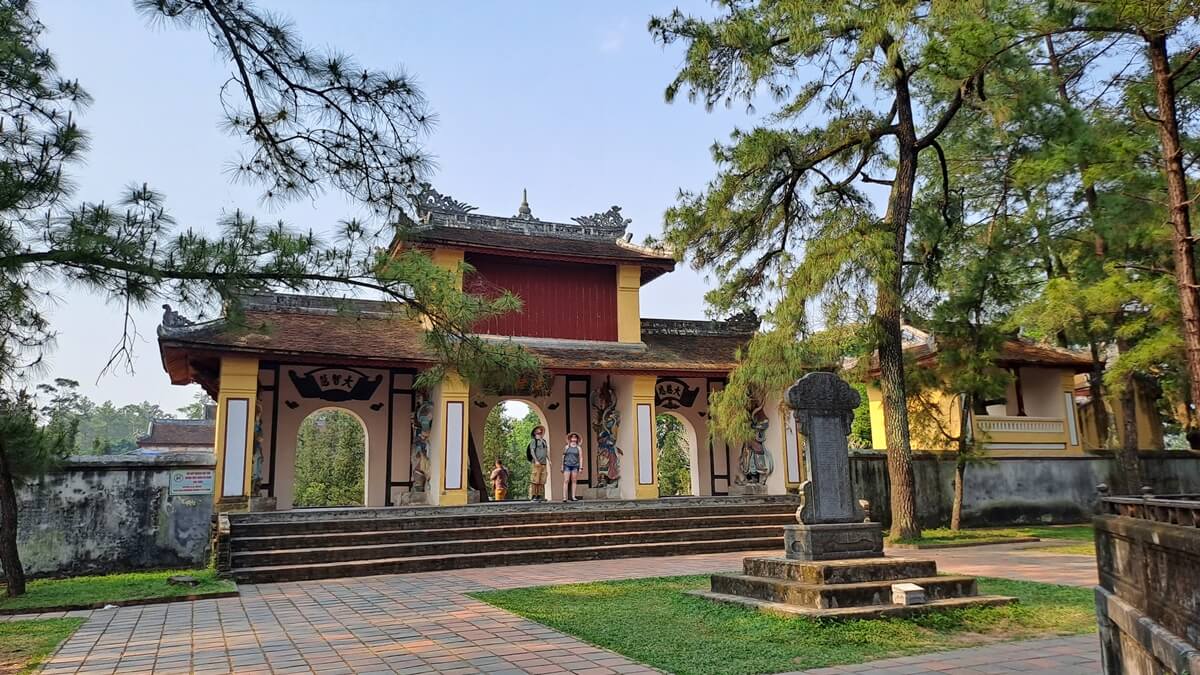
Tam Quan Gate serves as the main entrance to Thien Mu Pagoda and is located behind Phuoc Duyen Tower. The gate features three pathways, symbolizing the three worlds: the human, the devil, and the god. This architectural marvel has two floors and eight roofs, with a Buddhist shrine situated on the second floor of the central gate. The roof is adorned with distinctive patterns, and statues of Dharma Protectors stand on either side, guarding the entrance.
Phuoc Duyen Tower
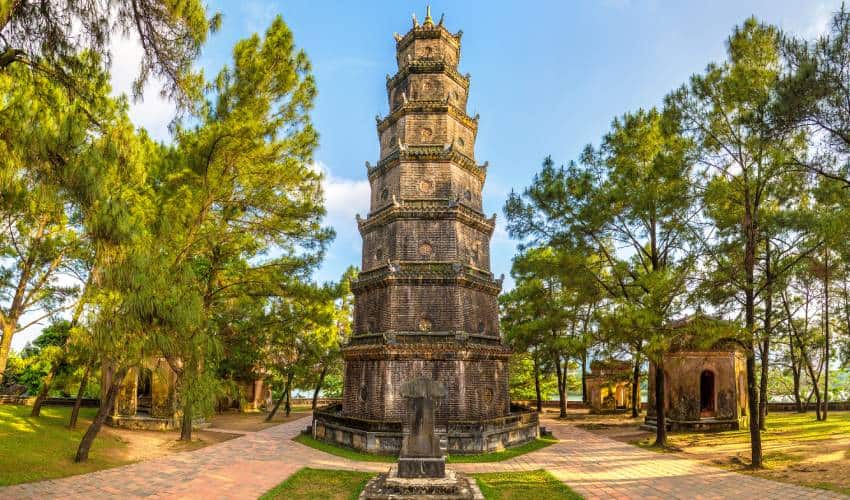
Phuoc Duyen Tower is an iconic check-in spot for visitors at Thien Mu Pagoda in Hue. Located just beyond the welcome gate, it is often considered the "soul" of the pagoda. This tower, along with other structures within the complex, creates a harmonious blend of unique architectural features that remain distinctly representative of Hue.
Built in 1844 by King Thieu Tri to commemorate the longevity ceremony of his grandmother, Queen Thuan Thien, the tower was originally named Tu Nhan Thap before being renamed Phuoc Duyen Tower. The construction required the transportation of materials such as clay, stones, and Bat Trang pottery from distant locations to complete this magnificent structure.
Phuoc Duyen Tower is constructed from rustic bricks with a stone curb, forming an octagonal structure. Standing 21 meters tall with seven floors, the tower narrows as it ascends. Each floor houses a Buddha statue, and a spiral staircase inside leads to the top floor, where the original golden Buddha statue resides. The design of each floor is identical and painted in pink, showcasing the architectural heritage of the ancient capital. Over the years, the tower has weathered the passage of time, further emphasizing its historical and cultural significance.
Dia Tang Palace
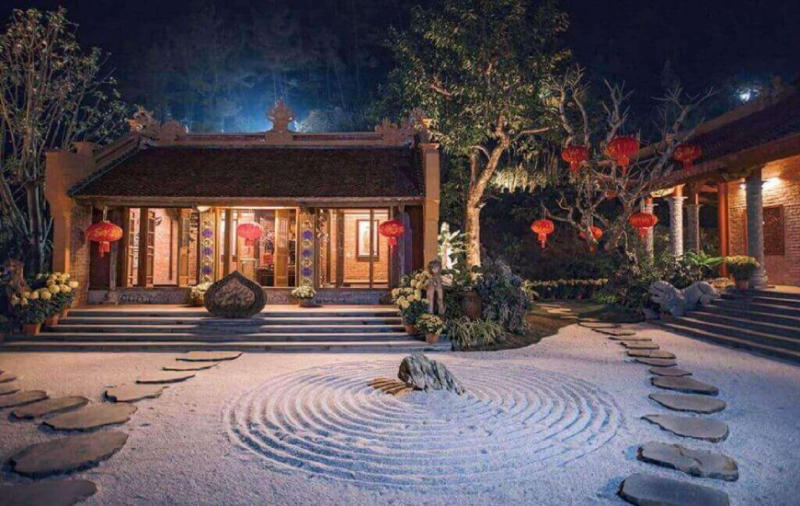
Located directly behind Dai Hung Palace, Dia Tang Palace and Quan The Am Palace are significant structures within Thien Mu Pagoda. Dia Tang Palace, built on the foundation of Maitreya, features intricate patterns and houses a bronze statue of Avalokitesvara Bodhisattva seated on a lotus base. On each side of the palace, there are altars dedicated to the worship of 10 Gods. In contrast, Quan The Am Palace is nestled in a grove and has a simple design without carved patterns, providing a serene and understated atmosphere.
Tomb of Venerable Thich Don Hau
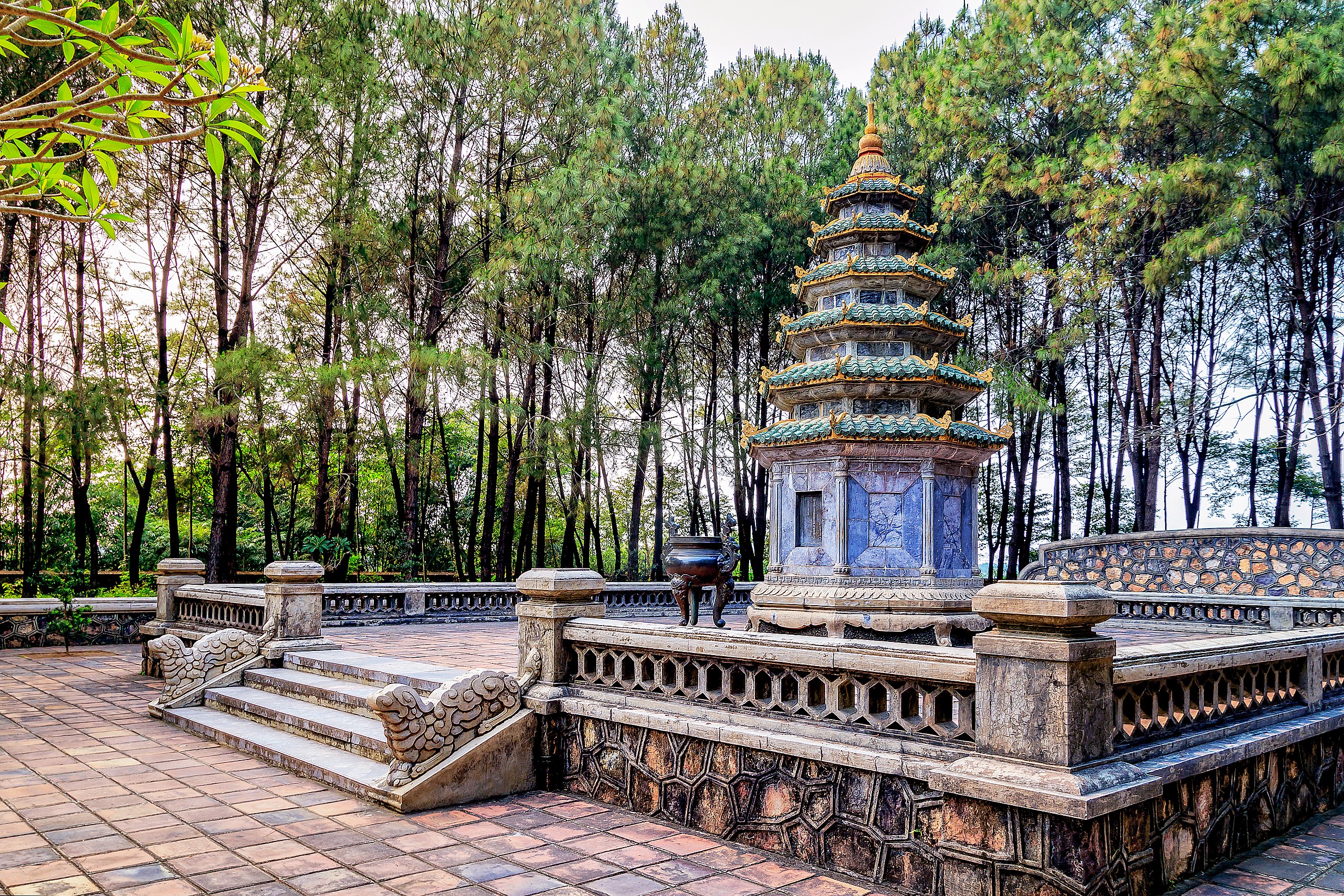
The Tomb of Venerable Thich Don Hau holds special significance within Thien Mu Pagoda. Venerable Thich Don Hau was a renowned abbot who dedicated his life to the advancement of Buddhism in Vietnam. Beyond his religious leadership, he earned widespread respect for his numerous community service efforts, tirelessly aiding those in need.
Upon his passing, citizens and pagoda administrators honored Venerable Thich Don Hau by burying him under the tower at the end of the pagoda's grounds. This act symbolizes their deep gratitude and reverence for his contributions and compassionate spirit.
Thien Mu Pagoda, renowned for its ancient architecture and spiritual significance along the Perfume River in Hue, embodies Vietnam's rich cultural heritage. After reading this article from Frontier Travel Vietnam, you'll appreciate the extraordinary beauty and history of Thien Mu Pagoda. If you're passionate about discovering historical and architectural treasures, make sure to visit this famous pagoda!







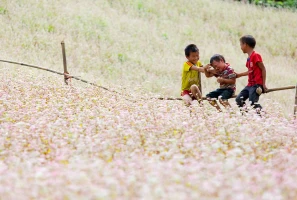

.png)